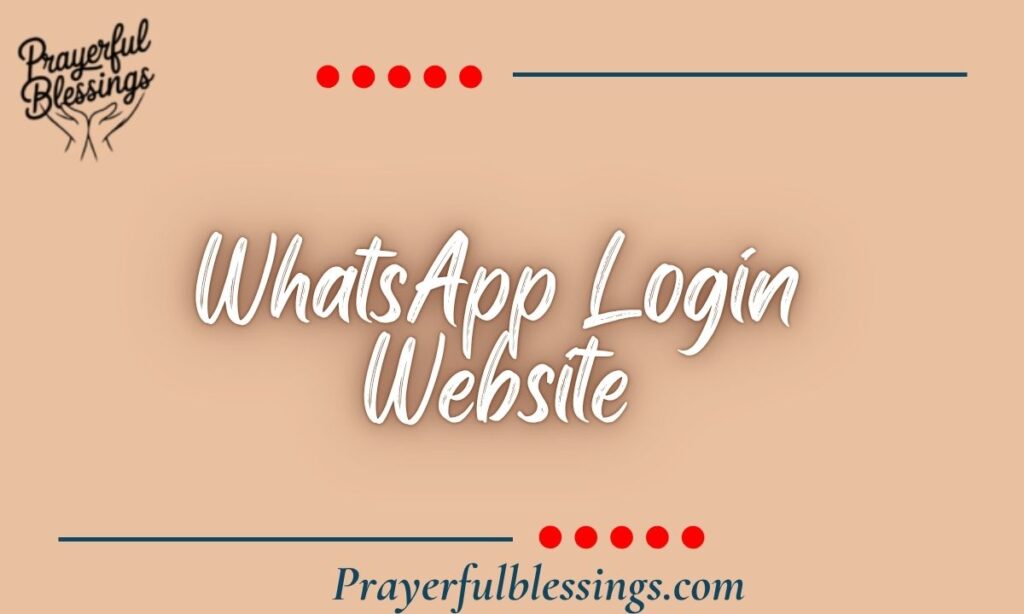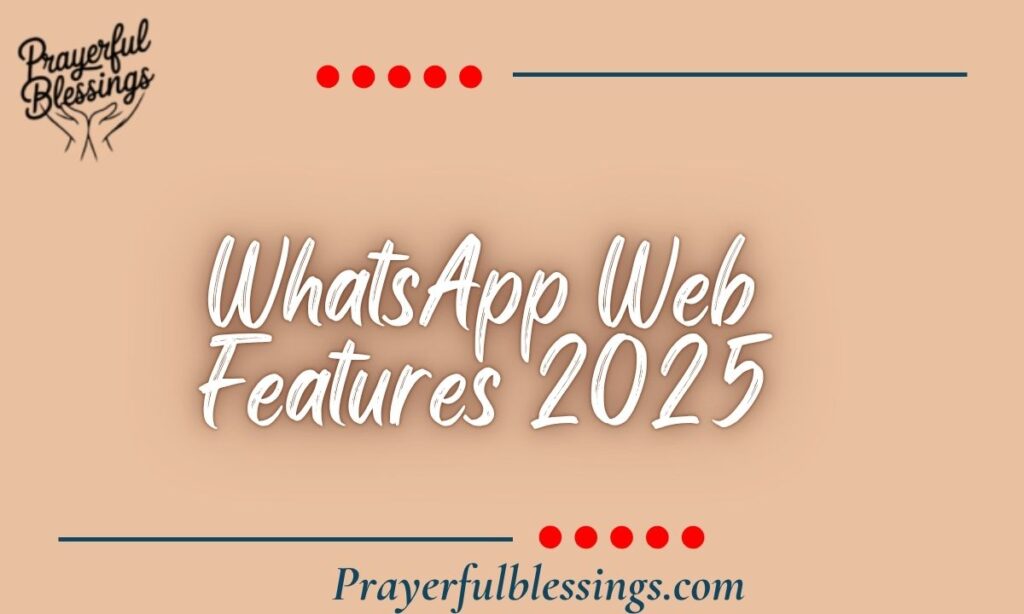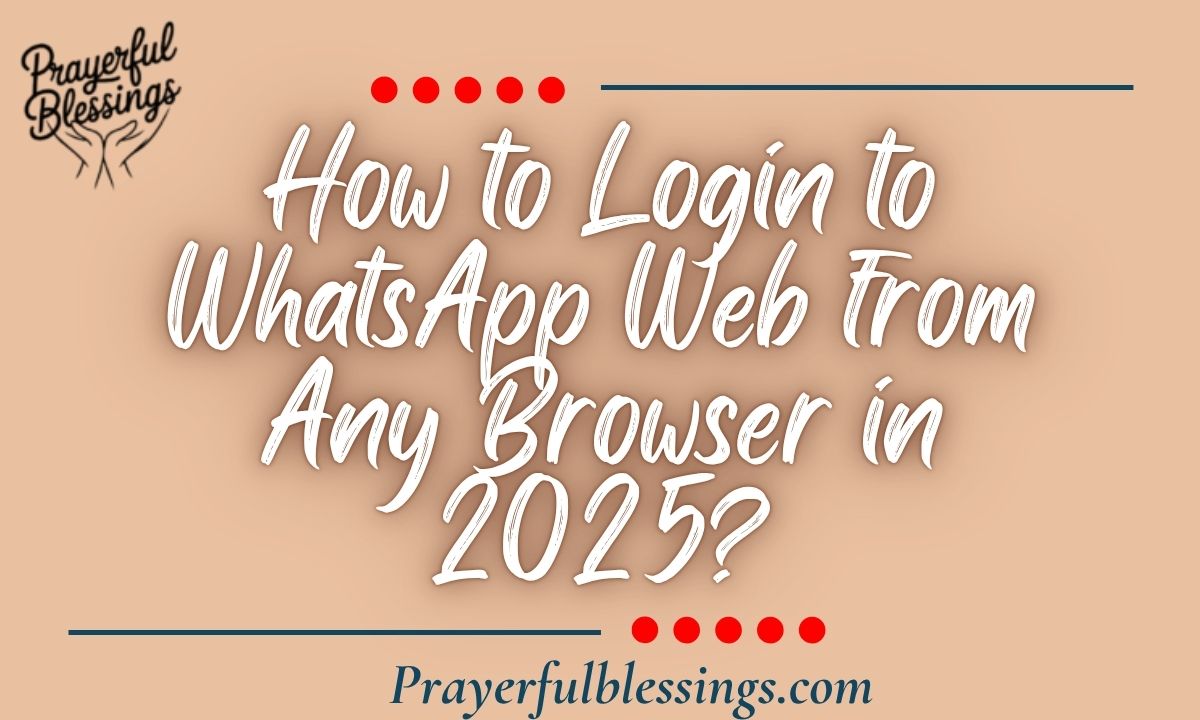WhatsApp Web has revolutionized how we communicate in the digital age. This comprehensive guide will walk you through every aspect of logging into WhatsApp Web from any browser in 2025. Whether you’re using a PC, Mac, or tablet, we’ve got you covered with step-by-step instructions and troubleshooting tips.
Key Takeaways
Understanding WhatsApp Web login is essential for seamless communication across devices. Here are the most important points to remember:
- WhatsApp Web requires an active internet connection on both your phone and computer
- The QR code scanning method remains the primary login technique in 2025
- You can access WhatsApp Web from any modern browser without downloading additional software
- Multi-device support allows you to stay logged in even when your phone is offline
- Security features have been enhanced to protect your personal data and conversations
WhatsApp Web offers the convenience of typing on a full keyboard while maintaining all your chat histories. The platform has evolved significantly, now supporting independent device operation without constant phone connectivity. Users can manage multiple sessions simultaneously while enjoying enhanced security protocols.
The 2025 version includes advanced features like improved media sharing, better file management, and streamlined group administration tools. Understanding the login process ensures you maximize these capabilities while maintaining account security.
WhatsApp Login Website

The official WhatsApp Web portal is accessible through web.whatsapp.com. This platform serves as your gateway to desktop messaging.
Accessing the WhatsApp login website is straightforward and universal. The platform supports all major browsers including Chrome, Firefox, Safari, Edge, and Opera. Simply navigate to the official URL to begin your login journey.
The website interface is clean and intuitive, featuring a prominent QR code display area and simple instructions. The platform automatically detects your browser and optimizes the experience accordingly. No plugins or extensions are required for basic functionality.
Supported Browsers for WhatsApp Web
| Browser | Minimum Version | Recommended Version | Special Features |
| Google Chrome | 60+ | Latest | Best performance, full features |
| Mozilla Firefox | 55+ | Latest | Enhanced privacy controls |
| Safari | 11+ | Latest | Optimized for Mac users |
| Microsoft Edge | 79+ | Latest | Windows integration |
| Opera | 50+ | Latest | Built-in VPN support |
Accessing WhatsApp Web
Accessing WhatsApp Web begins with ensuring you have the necessary prerequisites. Your smartphone must have the latest version of WhatsApp installed and an active internet connection.
The process is device-agnostic, meaning it works similarly across Android, iOS, and other platforms. However, the exact steps within the WhatsApp mobile app may vary slightly depending on your operating system version.
Browser compatibility is crucial for optimal performance. While WhatsApp Web functions on most modern browsers, using the latest versions ensures access to all features and security updates. Clear your browser cache periodically to maintain smooth operation.
How to Log Into WhatsApp Web
Logging into WhatsApp Web involves a simple yet secure process. The system uses QR code authentication to verify your identity and establish a secure connection.
The login mechanism leverages end-to-end encryption, ensuring your messages remain private during transmission. Each login session generates a unique authentication token that expires after a set period or manual logout.
Understanding the technical foundation helps troubleshoot issues effectively. The connection relies on WebSocket protocols for real-time message synchronization between your phone and browser.
Steps to Login to WhatsApp Web
Follow these detailed instructions to access WhatsApp Web successfully:
- Open your preferred web browser on your computer
- Navigate to web.whatsapp.com in the address bar
- Wait for the QR code to appear on your screen
- Open WhatsApp on your smartphone
- Tap the three dots (Android) or Settings (iPhone) to access the menu
- Select “Linked Devices” from the menu options
- Tap “Link a Device” to activate your camera
- Point your phone’s camera at the QR code on your computer screen
- Wait for the scanning process to complete
- Your chats will automatically load on the web interface
The entire process typically takes less than 30 seconds with a stable internet connection. The QR code refreshes every 60 seconds for security purposes, so scan promptly after it appears.
Additional options include checking the “Keep me signed in” box to maintain your session for extended periods. This feature stores authentication tokens locally, allowing quicker access during subsequent visits.
Device Login
Device login options have expanded significantly in 2025. WhatsApp now supports simultaneous connections across multiple devices without requiring your phone to remain online constantly.
PC and Mac
Desktop computers offer the most comprehensive WhatsApp Web experience. The larger screen real estate improves readability and multitasking capabilities.
For PC users, WhatsApp Web integrates seamlessly with Windows 10 and 11. The platform supports keyboard shortcuts for faster navigation and message composition. Right-click functionality provides quick access to message options.
Mac users benefit from native integration with macOS features. The platform supports trackpad gestures, notification center integration, and Continuity features when using Safari. The interface follows Apple’s design guidelines for a familiar user experience.
Both platforms support the WhatsApp Desktop application as an alternative to the web version. The desktop app offers enhanced performance, native notifications, and better system integration.
Android Devices
Android users access WhatsApp Web through a straightforward process. The interface within the mobile app has been optimized for quick device linking.
Navigate to the three-dot menu in the top-right corner of your WhatsApp application. Select “Linked Devices” to view all active sessions and add new connections. The camera interface includes alignment guides to simplify QR code scanning.
Android-specific features include battery optimization settings that may affect connection stability. Ensure WhatsApp is excluded from battery-saving restrictions for uninterrupted service.
iPhone Devices
iPhone users follow a slightly different path to access WhatsApp Web. The settings menu is located at the bottom-right of the app interface.
Tap “Settings” followed by “Linked Devices” to begin the connection process. iOS users benefit from Face ID or Touch ID authentication before scanning QR codes, adding an extra security layer.
iOS-specific considerations include background app refresh settings that must be enabled for proper synchronization. iCloud backup settings don’t affect WhatsApp Web functionality but ensure your chat history remains secure.
Tablets
Tablet devices now support native WhatsApp Web access in 2025. Both iPad and Android tablets can run WhatsApp independently without requiring a linked phone.
For iPads, download the WhatsApp application from the App Store and register using your phone number. The interface is optimized for tablet screen sizes with split-view support.
Android tablets follow similar procedures, with the added benefit of multi-window support for enhanced productivity. The tablet interface combines the best aspects of mobile and desktop experiences.
WhatsApp Web Login with SheetWA
SheetWA represents an innovative approach to bulk messaging through WhatsApp Web. This tool integrates Google Sheets with WhatsApp for efficient communication management.
SheetWA Setup
Setting up SheetWA requires initial configuration within Google Sheets. The extension provides automated messaging capabilities for business communications.
Install the SheetWA add-on from the Google Workspace Marketplace. Grant necessary permissions for the extension to access your Google Sheets and interact with WhatsApp Web. Complete the authentication process by logging into WhatsApp Web through the SheetWA interface.
Configuration options include message templates, scheduling features, and delivery tracking. The setup wizard guides you through each step, ensuring proper integration.
Data Preparation
Proper data formatting is crucial for SheetWA functionality. Your Google Sheet must include specific columns for recipient information and message content.
Create columns for phone numbers, names, custom variables, and message content. Include country codes in international format (+1, +44, +92, etc.) for accurate delivery. Remove any spaces or special characters from phone numbers.
Data validation features in Google Sheets help maintain consistency. Use dropdown menus for standardized fields and conditional formatting to highlight errors before sending.
Sending Messages
Message dispatch through SheetWA follows an automated workflow. The system processes your spreadsheet data and sends individualized messages through WhatsApp Web.
Select the recipients from your prepared sheet using checkboxes or filters. Choose your message template and customize any dynamic fields. Set delivery timing preferences for immediate or scheduled sending.
Batch processing allows you to send hundreds of messages efficiently. The system respects WhatsApp’s rate limits to prevent account restrictions while maintaining delivery speed.
Message Personalization
Personalized messaging increases engagement and response rates. SheetWA supports dynamic field insertion for customized communications.
Use variable placeholders like {Name}, {Company}, or {OrderNumber} within your message templates. The system automatically replaces these with corresponding values from your spreadsheet. This creates unique messages for each recipient while maintaining efficiency.
Advanced personalization includes conditional content based on recipient data. Create sophisticated messaging workflows that adapt to customer segments or interaction history.
Troubleshooting WhatsApp Web
Technical issues can occasionally interrupt your WhatsApp Web experience. Understanding common problems and their solutions ensures minimal disruption.
QR Code Issues
QR code scanning problems are among the most common login obstacles. Several factors can prevent successful authentication.
Ensure your phone camera has proper permissions and functions correctly. Clean your camera lens and ensure adequate lighting for optimal QR code recognition. The QR code should fill most of your screen without being cut off.
Browser-related issues may prevent QR code generation. Disable browser extensions temporarily, clear cache and cookies, or try a different browser. Some security software may interfere with the QR code display.
- Refresh the webpage if the QR code doesn’t appear within 10 seconds
- Verify that JavaScript is enabled in your browser settings
- Check that your browser is updated to the latest version
- Disable ad blockers or privacy extensions temporarily
- Ensure your firewall isn’t blocking WhatsApp Web connections
Connection Problems
Connectivity issues can prevent proper synchronization between devices. Both your phone and computer require stable internet connections.
Check your network stability by testing other websites or applications. Switch between Wi-Fi and mobile data on your phone to identify connection issues. Router restarts often resolve temporary connectivity problems.
Firewall configurations in corporate or educational networks may block WhatsApp Web. Contact your IT department for assistance or use a personal mobile hotspot as an alternative.
Device Sync Errors
Synchronization problems occur when messages don’t appear consistently across devices. These issues typically stem from timing conflicts or outdated applications.
Update WhatsApp to the latest version on your smartphone. Force close and restart the application to refresh the connection. Log out of all WhatsApp Web sessions and reconnect to establish fresh synchronization.
Time zone mismatches between devices can cause display inconsistencies. Ensure both devices have correct time settings and automatic time zone detection enabled.
SheetWA-Specific Issues
SheetWA troubleshooting requires understanding both Google Sheets integration and WhatsApp Web connectivity. Common issues have straightforward solutions.
1. Data Formatting Problems
Incorrect data formats prevent successful message delivery through SheetWA. Phone numbers must follow specific conventions.
Ensure all phone numbers include country codes without special characters. Use the format: +[country code][phone number] without spaces or dashes. Remove any leading zeros after the country code.
Column headers must match SheetWA’s expected naming conventions. Case sensitivity matters, so “Phone Number” differs from “phone number.” Refer to SheetWA documentation for exact column names.
2. Country Code Settings
Country code configuration affects international message delivery. SheetWA requires properly formatted international numbers.
Use the plus symbol (+) before all country codes. Double-check country codes for accuracy, as incorrect codes lead to delivery failures. Maintain consistency throughout your spreadsheet.
Regional considerations include varying phone number lengths. Validate numbers against each country’s standard format before attempting delivery.
3. Message Delivery Report
Delivery tracking helps identify successful and failed message attempts. SheetWA provides detailed reporting within your Google Sheet.
Monitor the status column for real-time updates during message campaigns. Common status indicators include “Sent,” “Failed,” “Pending,” and “Invalid Number.” Use this data to clean your contact list and improve future campaigns.
Failed messages require investigation. Common causes include blocked numbers, disconnected accounts, or rate limiting. Export failure reports for detailed analysis.
4. Media Attachment Errors
Media file problems prevent images, documents, or videos from being shared through SheetWA. File size and format restrictions apply.
Keep file sizes under WhatsApp’s limits: 16MB for all media types. Supported formats include JPG, PNG, PDF, DOC, and MP4. Store media files in Google Drive and share accessible links in your spreadsheet.
Permission settings on shared files must allow public or domain access. Private files will fail to attach, resulting in text-only message delivery.
5. Consent and Opt-Out
Legal compliance requires proper consent mechanisms when using bulk messaging tools. SheetWA users must respect recipient preferences.
Maintain an opt-out list within your spreadsheet to exclude contacts who request removal. Include unsubscribe instructions in your messages where appropriate. Document consent for marketing communications.
Privacy regulations like GDPR and local laws govern bulk messaging practices. Familiarize yourself with applicable regulations in your jurisdiction and recipient locations.
Security and Privacy
Security measures protect your WhatsApp Web sessions from unauthorized access. Understanding these features helps maintain account integrity.
Safe Login Practices
Secure authentication begins with careful QR code handling. Never share screenshots of active QR codes, as they provide complete account access.
Use private networks when logging into WhatsApp Web from public locations. Avoid public Wi-Fi without VPN protection. Enable two-step verification in your WhatsApp settings for enhanced account security.
Physical security matters when leaving your computer unattended. Lock your screen or log out of WhatsApp Web before stepping away. Enable automatic screen locking on your computer.
Managing Active Sessions
Session management allows you to monitor and control all devices accessing your WhatsApp account. Regular audits prevent unauthorized access.
Review linked devices regularly through your smartphone app. Each session displays the browser type, operating system, and last active time. Remove any unfamiliar or outdated sessions immediately.
Automatic logout occurs after extended periods of inactivity. Adjust these settings based on your security preferences and usage patterns.
Data Protection with SheetWA
SheetWA security requires protecting your Google Sheets data and managing access permissions carefully. Sensitive contact information needs safeguarding.
Limit sheet sharing to essential personnel only. Use view-only permissions where appropriate and require authentication for access. Enable version history to track changes and identify potential data breaches.
API credentials and authentication tokens should never be shared publicly. Store sensitive configuration details securely and rotate credentials periodically.
WhatsApp Web Features 2025

Enhanced functionality in 2025 has expanded WhatsApp Web’s capabilities significantly. New features improve productivity and user experience.
Multi-Device Support
Independent device operation allows WhatsApp Web to function without your phone being online. This revolutionary feature uses end-to-end encrypted cloud synchronization.
Connect up to four devices simultaneously without draining your phone battery. Each device maintains a separate encrypted connection to WhatsApp’s servers. Messages sync instantly across all linked devices.
Device-specific settings let you customize notification preferences for each platform. Mute desktop notifications during specific hours while maintaining phone alerts.
New Interface Updates
Redesigned interface elements improve navigation and accessibility. The 2025 update introduced streamlined menus and enhanced visual hierarchy.
The chat list now includes improved filtering options for unread messages, groups, and broadcasts. Quick action buttons provide faster access to common tasks like search, new chat, and settings.
Dark mode optimization reduces eye strain during extended usage. The theme adapts automatically based on system preferences or manual selection.
Enhanced Messaging Tools
Advanced features expand creative expression and communication efficiency. New tools support richer interactions.
Message reactions have expanded beyond basic emojis to include custom reactions and animated responses. Edit sent messages within 15 minutes of delivery, with edit history visible to recipients.
Voice message transcription converts audio to text automatically, improving accessibility. Enhanced media editing tools allow in-app image cropping, text overlay, and filter application.
Logging Out and Session Management
Proper logout procedures ensure account security when finishing WhatsApp Web sessions. Understanding session controls prevents unauthorized access.
How to Log Out
Logging out terminates your active WhatsApp Web session and removes stored authentication tokens from your browser.
Click the three-dot menu in the upper portion of the WhatsApp Web interface. Select “Log out” from the dropdown options. Confirm your action when prompted. Your chat interface will close, and the QR code login screen will reappear.
Automatic logout occurs after 14 days of inactivity on “Keep me signed in” sessions. Non-persistent sessions expire immediately upon closing the browser window.
Remote Logout
Remote session termination allows you to close WhatsApp Web sessions from your smartphone. This feature is crucial if you forget to log out on shared computers.
Open WhatsApp on your phone and navigate to Settings > Linked Devices. View all active sessions with their device types and last active timestamps. Tap any session and select “Log Out” to terminate that connection remotely.
Immediate disconnection prevents further access from that device. The remote user will see a connection lost message and must rescan the QR code for new access.
Session Security
Security protocols protect your WhatsApp Web sessions from various threats. Understanding these measures helps maintain privacy.
Each login generates unique encryption keys that secure data transmission between devices. These keys rotate periodically and become invalid after logout. Cookies stored in your browser are encrypted and device-specific.
Browser security settings affect WhatsApp Web safety. Disable password saving for public computers, use private browsing mode when appropriate, and keep your browser updated with the latest security patches.
FAQ’s
How do I scan the QR code for WhatsApp Web?
Open WhatsApp on your phone, tap the menu icon, select “Linked Devices,” tap “Link a Device,” and point your camera at the QR code displayed on your computer screen.
Can I use WhatsApp Web without my phone nearby?
Yes, the 2025 multi-device feature allows WhatsApp Web to work independently after initial setup, even when your phone is turned off or disconnected.
Is WhatsApp Web secure for sensitive conversations?
Yes, WhatsApp Web uses end-to-end encryption identical to the mobile app, ensuring your messages remain private and secure during transmission.
Why won’t my QR code scan properly?
Common causes include poor camera quality, insufficient lighting, outdated app versions, browser compatibility issues, or network connectivity problems preventing QR code generation.
Can I use WhatsApp Web on multiple computers simultaneously?
Yes, you can link up to four devices simultaneously, including computers, tablets, and browsers, all functioning independently with synchronized messages.
How do I access WhatsApp Web on my iPad?
Download the WhatsApp app directly from the App Store on your iPad and register with your phone number for native functionality without requiring QR code scanning.
What is SheetWA and how does it work?
SheetWA is a Google Sheets extension that enables bulk messaging through WhatsApp Web by processing spreadsheet data and automating personalized message delivery.
How can I troubleshoot connection problems on WhatsApp Web?
Check internet connectivity, update your browser, clear cache and cookies, disable interfering extensions, ensure your phone has a stable connection, and try restarting both devices.
Will logging out of WhatsApp Web delete my messages?
No, logging out only terminates your session on that device; all messages remain stored in your WhatsApp account and accessible from your phone or other linked devices.
Can I send WhatsApp messages from Google Sheets automatically?
Yes, using tools like SheetWA, you can automate bulk messaging by preparing recipient lists and message templates in Google Sheets for efficient campaign management.
Final Thoughts
WhatsApp Web in 2025 has evolved into a powerful communication platform that bridges mobile and desktop experiences seamlessly. The login process remains simple yet secure, utilizing QR code authentication to protect your account while providing quick access.
Understanding the various device options—from PCs and Macs to Android phones, iPhones, and tablets—ensures you can stay connected regardless of your preferred hardware. The addition of multi-device support has revolutionized how we use WhatsApp, eliminating the frustration of phone dependency.

Meet Eman, the heart and soul behind PrayerfulBlessings! With a deep understanding of prayers and blessings, she crafts heartfelt messages that inspire and uplift. Whether you’re seeking comfort, guidance, or strength, Eman’s carefully crafted prayers offer a sense of peace and hope. Let her words bring warmth and positivity to your day, filling your heart with faith and gratitude. Get ready to experience the power of prayer!

